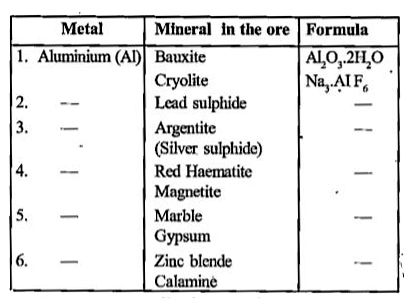Complete the following tables:

Video Solution
Text Solution
For nitrogen atom. No. of electrons = 7(Given)
No. of neutrons = 7 (Given)
No. of protons = Z = 7 ( atom is electrically neutral)
Atomic number = Z = 7
Mass No. (A) = No. of protons + No. of neutrons
For calcium ion. No. of neutrons = 20 (Given) , Atomic No. (Z) = 20 (Given)
No. of protons = Z = 20, No. of electrons in calcium atom = Z = 20
But in the formation of calcium, two electrons are lost from the extranuclear part according to the equations but the composition of the nucleus remains unchanges.
No. of electrons in calcium
Mass number (A) = No. of protons + No. of neutrons
For oxygen atom. Mass number (A) = No. of protons + No. of neutrons = 16(Given)
Atomic No. (Z) = 8 (Given)
No. of protons = Z = 8, No. of electrons = Z = 8, No. of neutrons
For bromide ion. In the formation of bromide ion, one electron is added to the extranuclear part of the bromine atom according to the equation but the composition of the nucleus remains unchanged.
Since the no. of electrons in bromide ion = 36 (Given)
No. of electrons in bromine atom
Further, since in the above reaction, nucleus of the bromine atom remains unchanged.
No. of protons in the bromide ion = No. of protons in the bromine atom = 35
Putting the value of the various vacant place as calculated above, in the table, we have

|
Updated on:21/07/2023
Topper's Solved these Questions
- BOOK - PRADEEPCHAPTER - STRUCTURE OF ATOMEXERCISE - Problem35videos
STRUCTURE OF ATOM
- BOOK - PRADEEPCHAPTER - STRUCTURE OF ATOMEXERCISE - Curiosity Question6videos
STRUCTURE OF ATOM
- BOOK - PRADEEPCHAPTER - STATES OF MATTER: SOLID MATTEREXERCISE - COMPETITION FOCUS (ASSERTION-REASON)17videos
STATES OF MATTER: SOLID MATTER
- BOOK - PRADEEPCHAPTER - THERMODYNAMICSEXERCISE - MULTIPLE CHOICE QUESTION ( BASED ON PRACTICAL CHEMISTRY)3videos
THERMODYNAMICS


